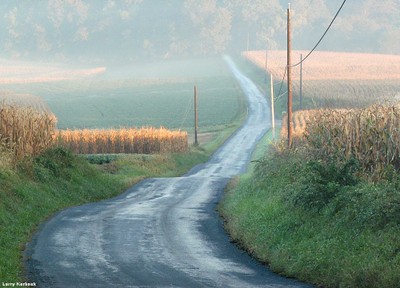Do Roads Drive Forest Plant Invasions?
Roads provide a means for moving people and products, but they can also allow hitchhiking organisms to spread. Some exotic invasive plants thrive on the disturbance created by road construction that displaces native plants, but researchers found that the presence of a road may be less important than the presence of farms and other human activities nearby. The research was awarded an “editors’ choice” award from the journal Diversity and Distributions (March 2018).
 While there is little doubt that roads are linked to forest plant invasions at local scales, effective resource conservation at
regional scales requires an understanding of other factors linked to both roads
and invasions across the larger landscape. Eastern Forest Environmental Threat Assessment
Center researchers and partners developed a series of models that allowed them
to see the incremental influences of land use (including agriculture and
development), forest fragmentation, local site conditions, and regional
ecosystem characteristics in comparison to road proximity effects in eastern
U.S. forest plant invasions. As reported in the journal Diversity and Distributions, regional ecosystem
characteristics best explained the odds of invasion. The next best predictors
of invasion were land use, site productivity, forest fragmentation, and
distance from a road, respectively. Because roads and human activities
surrounding them are so pervasive in the East, land managers should be thinking
of ‘human impact zones’ instead of just ‘road effect zones’ when evaluating the
risk of forest plant invasions. The context of the road is key.
While there is little doubt that roads are linked to forest plant invasions at local scales, effective resource conservation at
regional scales requires an understanding of other factors linked to both roads
and invasions across the larger landscape. Eastern Forest Environmental Threat Assessment
Center researchers and partners developed a series of models that allowed them
to see the incremental influences of land use (including agriculture and
development), forest fragmentation, local site conditions, and regional
ecosystem characteristics in comparison to road proximity effects in eastern
U.S. forest plant invasions. As reported in the journal Diversity and Distributions, regional ecosystem
characteristics best explained the odds of invasion. The next best predictors
of invasion were land use, site productivity, forest fragmentation, and
distance from a road, respectively. Because roads and human activities
surrounding them are so pervasive in the East, land managers should be thinking
of ‘human impact zones’ instead of just ‘road effect zones’ when evaluating the
risk of forest plant invasions. The context of the road is key.
Pictured: Researchers found that land use within ‘road
effect zones’ is an important predictor of forest plant invasions. Photo by Larry Korhnak, Interface South.
Related publications:
Forest Service Partners/Collaborators: Southern Research Station
External Partners/Collaborators: North Carolina State University, University of Florida, Purdue University
Contact: Kurt Riitters, Research Ecologist, kurt.h.riitters@usda.gov



